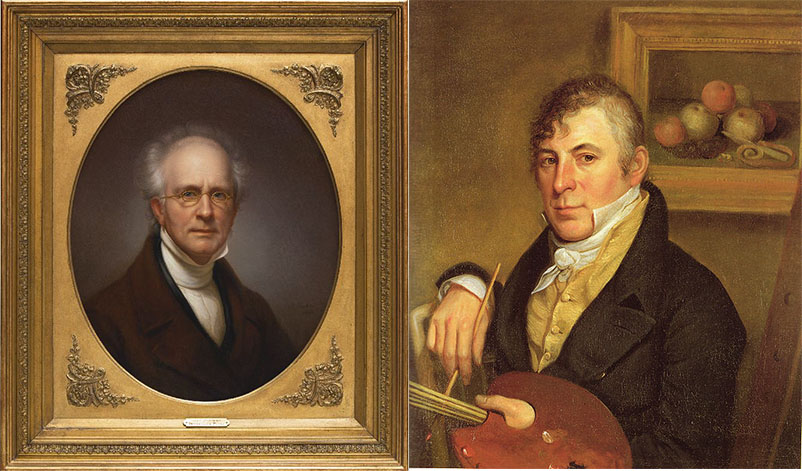
Left: Rembrandt Peale, 1778 – 1860
Self-portrait, 1846
Oil on canvas
Crystal Bridges Museum of American Art, Bentonville, AR
Right: Charles Willson Peale (American artist, 1741-1827)
Portrait of his son Raphaelle Peale, 1822
Oil on canvas
This month, we celebrate the birthdays of Raphaelle and Rembrandt Peale, (February 17 and 22, respectively) two brothers from America’s first artist family.
Raphaelle and Rembrandt’s grandfather, Charles Peale (1709 – 1750), worked as a clerk for a British post office until he was caught in an embezzlement scheme, found guilty of forgery, and sentenced to death. Thanks to some important friends, Charles avoided the sentence but was instead exiled to America, where he married and had five children. After his early death, his eldest son, Charles Willson Peale (1741 – 1827), took over family responsibility. At that time, no one in the family was an artist, but during a business trip in Virginia, Charles Willson saw some landscapes and portraits that he considered poorly done, and thinking he could do better (and hating his saddlery job), he began to immerse himself in the art world. Then, while running from the debts accrued by his saddlery business, Charles Willson met John Singleton Copley, a connection that would grant Charles Willson more opportunities to practice painting and eventually to make a trip to study art in England.
The skills learned during this trip and Charles’s strong belief in the importance of education within a family inspired Charles Willson Peale to share his knowledge with his 11 children (many of them named after famous artists), his brother James, and his nieces and nephews after settling down in Philadelphia and starting the Philadelphia Museum. And thus the Peale art family was born.
As the eldest of Charles Willson’s sons, Raphaelle (February 17, 1774 – 1825) worked primarily as an assistant to his father’s museum business, running errands and arranging exhibits, among other tasks, but like all the Peale children, he was trained in portraiture. Portraits were especially popular in England as a means of establishing a national identity, and they seemed even more urgent for the United States, fresh from its victory in the Revolutionary War. Although Raphaelle painted some portraits, typically miniatures, he broke away from his family’s focus on portraiture, choosing instead to dedicate himself to still life paintings, which were popular in the Netherlands, but considered amateur for the English. Unfortunately, this sentiment meant Raphaelle received little respect or attention for his work, even from Charles Willson, who recognized Raphaelle’s skill with still life but hoped he would put that skill toward a form of painting considered more acceptable. Raphaelle spent most of his life poor and frequently sick, and it wouldn’t be until modern times that the art world would recognize the brilliance of his still life paintings, such as After the Bath, (also known as Venus Rising from the Sea—A Deception) (1822) and Corn and Cantaloupe (1813), which is part of the Crystal Bridges permanent collection.

Raphaelle Peale (1774-1825)
After The Bath, 1823
Nelson Atkins Museum, Kansas City, Missouri

Raphaelle Peale (1774-1825)
Corn and Cantaloupe, ca. 1813
Oil on panel Crystal Bridges Museum of American Art
Rembrandt (February 22, 1778 – 1860), the third surviving child of Charles Willson, had a different experience. Having fewer museum duties than Raphaelle, Rembrandt spent more time watching and assisting his father with portraits, and he was getting commissions by the age of 16. Rembrandt’s natural talent and dedication to portraiture eventually drew him to Europe, where he studied extensively in England, Paris, and Italy. By doing so, he became artistically independent of his father: while Charles Willson used background symbols to tell a story, Rembrandt emphasized the individuality of his models by focusing on craft and relationships between colors. This style can be seen in his many portraits, including ones of George Washington (with whom he shares a birthday), Thomas Jefferson, John C. Calhoun, and the other Peales. His portraits of Washington were particularly popular, especially Patriae Pater (1824), which he replicated more than 70 times throughout his life. In addition to these, Rembrandt painted landscapes, history paintings, and a series of at least seven self-portraits that cataloged his life and growth as an artist, the first completed when he was 13 and the last when he was 78. Rembrandt also started the Baltimore Museum, and was part of the American Academy of Fine Arts in New York and the Washington Art Association.

Rembrandt Peale (1778 – 1860)
George Washington (Patriæ Pater)
Oil on canvas, 1824
Collection of the US Senate
Although their lives went in drastically different directions, Raphaelle, Rembrandt, and the entire Peale family are important figures in American history. Raphaelle’s still life paintings and Rembrandt’s portraits all contributed to the creation of a national identity, and their artistry, in conjunction with their museum work, established the beginnings of an American artistic tradition.
Sources: (These books and more can be found in the Crystal Bridges Library.)
The Peale Family: Creation of a Legacy 1770-1870 edited by Lillian B. Miller
Rembrandt Peale 1778-1860: A Life in the Arts organized by Carol Eaton Hevner



